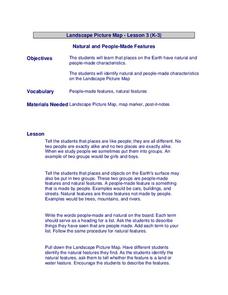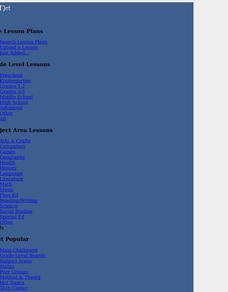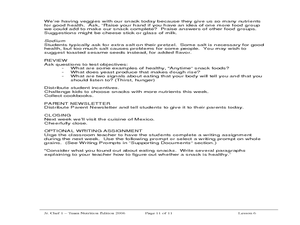Curated OER
Play Ball: A Major League Review Game
Apply the game of baseball to a fun review activity. Pupils earn a "base" for each subject question that they answer correctly. This activity can be modified and used for any subject area, including math, social studies, and language arts.
Curated OER
Alphabetize For A Reason
Students organize information by using the alphabet. Students organize materials alphabetically. Students alphabetize with the first, second and third letters of a set of words. Students discover applications for alphabetical order.
Curated OER
Patriotic Symbols of the United States
Young historians take a close look at the most famous patriotic symbols of the United States and determine what they actually stand for. Symbols such as Uncle Sam, The Statue of Liberty, The Bald Eagle, and The Liberty Bell are studied....
Curated OER
Sneetches: Diversity of Learners
For Learners wanting to practice verbal/linguistic intelligence, any Dr. Seuss book is an excellent text for examining rhyming words. They explore words that rhyme with bully, mean, snooty, nasty, tease, harass, hurt.
Curated OER
A Better Class of Journal-ists
Young academics create a current events journal by skimming newspapers for articles that fit defined guidelines for informational texts. After cutting out two articles each week to add to their journals, they write a brief description of...
University of Kansas
Newspaper in the Classroom
Newspapers aren't only for reading—they're for learning skills, too! A journalism unit provides three lessons each for primary, intermediate, and secondary grades. Lessons include objectives, materials, vocabulary, and procedure, and...
Mississippi State University
The Five Senses
Your learners engage their five senses every day without knowing it. Help them identify their experiences and extend their understanding with a month full of lessons designed for the five senses. Kids focus on a different sense every...
Curated OER
What is a Haiku? How Do You Write a Haiku?
Haiku poetry is explored in this language arts lesson. Yong readers identify the characteristics of haiku and read several examples. Students make connections between their study of Japan and the poetic form of haiku, and they write...
Curated OER
Water, Water Everywhere
Students study the location of Earth's water and study the water cycle using a terrarium. In this water study instructional activity, students study a model globe for the Earth and find Alaska. Students locate the bodies of water and...
Curated OER
Landscape Picture Map
Students discuss differences between man made and natural features on the Earth's surface. For this natural and man made features lesson, learners brainstorm a list of features and categorize them on the board. Students study a landscape...
Curated OER
The Love and Safety Club for Children
Child safety and bullying is the focus of this sociology lesson plan. The Love and Safety Club is a program for children which is designed to help reinforce important information regarding how to stay safe at home, at school, and when...
Curated OER
Habitats: must live with them....cannot live without them.
Students conduct an internet study regarding habitat, ecosystem, biome and the region they live in. They observe the habitat by visiting a State Park and observing the organisms in their habitat. In addition, they create their own...
Curated OER
Rhythm in Language - Feel the SWAMP BEAT!
Students explore the rhythm of words. In this reading skills lesson, students read Bedtime at the Swamp and use rhythm instruments to find the cadence in the words of the story. Students listen for rhythm in other written text as they...
Curated OER
What Are You Doing? ??Que Pasa?
Learners better appreciate the variety and utility of languages spoken around the world. Then they study everyday words in two languages. Students also construct a system of flashcards to learn and test their new vocabulary knowledge.
Curated OER
Dictionary Skills
Second graders use resources such as dictionaries and glossaries correctly to build word meaning and to practice all uses of their references; students also practice alphabetical order while locating information.
Curated OER
Flat Stanley Lesson 8- Vocabulary- 42-46
In this vocabulary and word study worksheet, students complete work with phonograms in Lesson 8, based on Flat Stanley. They work with the phonograms; a, ti, c, ed, e, igh, ed, and qu, although no directions are given.
Curated OER
Reaching to the Clouds for Equality
Students explore the concept of equality. In this Martin Luther King, Jr. lesson, students read Martin's Big Words, discuss fairness, and create a cloud with their dream recorded on it.
Curated OER
Social Studies: African Banner Boxes
Students write creation stories and design stamps to use on banners accompany them. They discuss the use of stamps in African culture to take the place of words. Students use a handout of stamps and their own creations to create banners...
Curated OER
Jr. Chef Club Super Snacks Lesson 6
Students explore healthy snacks. In this nutrition and cooking lesson, students observe and identify food groups on USDA's MyPyramid food guide. Students discuss how fiber helps our digestive system and follow a recipe using yeast to...
Curated OER
Not Your Grandma's Music: A Lesson in Music History
Students experience and discuss the different musical periods such as Baroque, Classical and Romantic. In this music lesson, students discover musical theory and apply it to the Baroque, Classical, and Romantic periods. Students will...
Curated OER
Build Skills and Word Experiences: Make Compound Words
Second graders complete spelling activities for compound words. In this compound words lesson, 2nd graders put words together to make compound words.
Curated OER
Instant Spelling Activity: Homophones
Second graders explore the concept of homophones. In this spelling skills activity, 2nd graders discover the definition of homophones and practice identifying homophones. Extension activities suggested are included with this activity.
Curated OER
Natural Features
Students identify natural features on a map. In this map skill instructional activity, students use a landscape picture map to identify mountains, hills, islands, lakes, and rivers. Students use post-it notes to demonstrate their location.
Curated OER
Simple Route Map
Learners identify the best route between various locations on a map. In this map skills lesson, students use a landscape picture map to find routes to and from certain places. Learners use map markers to highlight the routes.

























